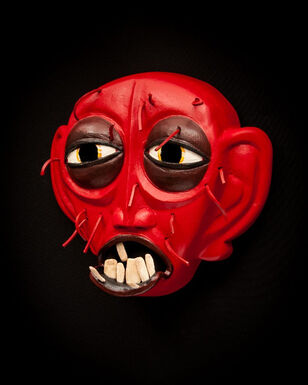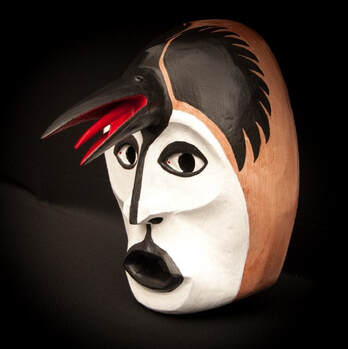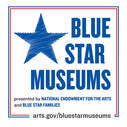Interpretations of Chinookan Characters by Bill Rutherford

"For years Lillian Pitt, internationally known Native American multimedia artist and educator, has challenged me to artistically honor my Indian heritage ... While working on another project, I came across a book, "Naked Against the Rain", by Rick Rubin. I read the book and was moved to try to carve several of the many spirits that the author identifies or describes in his book ... Ms. Pitt has acknowledged that these Chinookan spirit masks have satisfied her challenge to me, even though my heritage is (not Chinook but) Chickasaw." Bill Rutherford
It has been said that to be Chinook is to know and follow a myriad of taboos and protocols associated with every aspect of life. One important taboo is that "class" can only be conducted in late fall, winter and early spring terms. Telling stories outside of storytelling season could cause something bad to happen. Because of this, we only took a small look into the full story behind these masks. Thank you for joining us on this adventure.
The Chinook-inspired masks have been shown at the Cathlapotle Plankhouse in Ridgefield, Washington (July 2016), and at Fort Vancouver Visitor Center, Washington (summer 2018).
The collection was donated to the Columbia River Maritime Museum by Barbara Kommer, Kurt Koenig, Joan Levers and David Manhart. Interpretation by Tony Johnson (Chairman of the Chinook Indian Nation).
In the future, the masks will be moved into a Gallery in the Museum for Museum visitors to see and enjoy.
The Chinook-inspired masks have been shown at the Cathlapotle Plankhouse in Ridgefield, Washington (July 2016), and at Fort Vancouver Visitor Center, Washington (summer 2018).
The collection was donated to the Columbia River Maritime Museum by Barbara Kommer, Kurt Koenig, Joan Levers and David Manhart. Interpretation by Tony Johnson (Chairman of the Chinook Indian Nation).
In the future, the masks will be moved into a Gallery in the Museum for Museum visitors to see and enjoy.
For Chinookan peoples along the Columbia River, traditional myths and stories serve an important cultural role. More than mere stories, these myths function more as Chinookan Universities. These stories transfer important knowledge, about how to live and thrive on the river, how to interact with and tend to our non-human relatives (which many today call natural resources), important knowledge about social rules, cultural taboos, and interpersonal interactions. For many Chinookan people, these stories ARE a record of the past and how things have come to be, and a reminder of what could happen if these rules are not honored.
Introduction and mask descriptions provided by Tony Johnson, Chinook Nation Chairman, July 2016
Introduction and mask descriptions provided by Tony Johnson, Chinook Nation Chairman, July 2016

ATATHLIA (Aut-ta-clea-a)
A hideous ogress with huge eyes and big ears who comes out of the night fog carrying a large basket to take away children to eat them. She is also said to be the origin of biting insects - in
one story she is burned and embers from her burning body become mosquitos.
Size in inches: 10-1/2 h x 11-1/2 w x 3-3/4 d
Materials: Laminated white cedar, leather thongs, lamb ribs
Finish: Acrylic paint, satin topcoat

THE DARKNESS ONE
In the Myth Time, the Darkness One carries darkness with her in a box. In one myth
where the world is being made ready for humans, the Darkness One is told that she
can no longer control the changing of darkness into light.
Size in inches: 9-1/2 h x 11-1/2 w x 3-5/8 d
Materials: Laminated white cedar
Finish: Acrylic paint, satin topcoat

KAGOOTI (Ka-Goot-ee) (coyote shown inside of Flathead)
Kagooti, the trickster, is depicted inside the head of a Chinookan person (note the flattened forehead). Coyote is a key character in many myths across the Americas, as well as in the Pacific Northwest. Coyote can change his appearance to fool people and is excessive in everything that he does. Coyote eats and drinks too much, is a perpetual seducer, lies, cheats, steals and does things just to see if he can get away with it. He also goes around making the world ready for humans. HIs role in Chinookan culture is to set morals and instruct the People by telling them how to live.
Size in inches: 13 h x 15 w x 7-1/2 d
Materials: White cedar, papier mache', Larch fir bark, plywood veneer
Chinookan Flathead: Laminated white cedar
Finish: Acrylic paint, satin topcoat

YUHLMA
Yuhlma is a kind of invisible wild spirit that can make people ill. This mask represents
different kinds of illness - the European diseases that killed thousands of Chinookan and
other Native peoples across the greater Pacific Northwest. These introduced diseases, represented by skewers piercing the face, speak to how small pox, measles, cholera, tuberculosis, venereal disease, and alcoholism destroyed many villages and communities during the contact period. The descendants of those that survived these epidemics are still here today, though the cultures of the Lower Columbia River have been changed forever.
Size in inches: 11-3/4 h x 9-5/8 w x 5-1/2 d
Materials: Oak, white cedar, leather thongs, Bamboo sticks, wood buttons
Finish: Acrylic paint, satin topcoat

IKWANAT
Ikwanat is the head of the Salmon people. The Salmon myth is a perfect example of stories' roles in transferring traditional ecological knowledge. In the myth, Salmon goes around to foods including Wapato and Skunk Cabbage telling them that they will be food for the People when Salmon is not around. The gifts that he gives the different characters are useful for identifying the plants today. An example of this would be skunk cabbage. Salmon gives Skunk Cabbage elk skin armor and a bone club, which can be seen today in the flower of the skunk cabbage. The yellow outside is elk skin armor and the white flower spike is the bone club.
Size in inches: 21 h x 10 w x 5 d
Materials: Maple, white cedar, leather thong, copper wire
Finish: Acrylic paint, satin topcoat

ITCIXYAN
Itcixyn, the Swallowing Monster, lives in the Columbia River, and long ago swallowed anyone who would go in the water. Coyote heard about this and tricked Itcixyan into swallowing him so he could rescue the people. Afterward, Coyote announced once in a while people would
still drown, but the River would not take everyone.
Size in inches: 11-1/2 h x 9-3/4 w x 4-1/4 d
Materials: White cedar, copper wire
Finish: Acrylic paint, satin topcoat

PETROCLYPH ROCK WOMAN, She Who Watches
This mask depicts the petroglyph located near Horsethief Lake near Wishram, Washington, and though her name is widely known, Chinookan protocol states that you are not supposed to say her name. In the Myth Times, Coyote travelled the river making things ready for the arrival of humans. Along the way he changed numerous people into objects and animals that would later be used to provide for the People. In the place where this petroglyph stands, a female chief was turned into stone to watch over the People of her place.
Size in inches: 10-1/2 h x 11-1/2 w x 3-1/2 d
Materials: Laminated white cedar
Finish: Acrylic paint, satin topcoat

TILLAMOOK (Tilla-muk)
Wind, much like animals , is thought and spoken of as a person in the Myth Times.
There are winds from many directions, and they are associated with people of those
specific directions.
Size in inches: 10-1/2 h x 6 w x 12 d
Materials: Laminated white cedar
Finish: Acrylic paint, satin topcoat

KYAN KAU-KAU (Great Crow/Raven)
Raven is an important character in many Salish stories just to the north of Chinookan territory. Chinookan neighbors to the north tell the story depicted here - Raven in a messenger whose feathers were singed black as he stole from an old chief's magic box and flew the sun into the sky. In this mask, the crow/raven is seen speaking through the people's voice.
Size in inches: 10-1/2 h x 11-1/2 w x 3-1/2 d
Materials: Laminated white cedar, glass beads
Finish: Acrylic paint, satin topcoat





